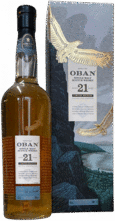Oban Single Malt Whisky is a West Highland malt, still produced in the same steadily slow, traditional fashion as it always has been since the distillery’s opening in 1784.
One of Scotland's smaller distilleries, (it’s, in fact, Diageo’s second smallest distillery in terms of production, larger only than Royal Lochnagar), Oban sits in the heart of the town of the same name and uses water from Loch Glenn a’Bhearraidh in its production.
The distillery is one of a very few distilleries in Scotland still using the traditional “worm tubs”, which are placed outside of the still house. There is also only one pot still and one wash still at Oban distillery. This is mainly due to the fact that Oban is also one of Scotland’s few remaining urban distilleries. With founders John and Hugh Stevenson having established a fishing hamlet around the site, the distillery itself stands on the main street, surrounded by other businesses.
Production at the Oban site began in 1794, and the two Stevenson brothers ran the operations together until Hugh Stevenson died in 1820. On the event of his fathers’ death, Hugh’s son, Thomas began to manage production, and acquiring the remaining stocks in the distillery in 1822, he gained total control of the site.
Despite Thomas Stevensons’ positive start he was sadly declared bankrupt a few years later Thomas’ eldest son, John, swiftly took over operations at the distillery, after buying it from his fathers’ creditors for the price of £1’500 in 1831.
In 1898, the distillery was taken over by the Oban & Aultmore-Glenlivet Company. Around about this time, however, Oban suffered enormous losses due to the Pattison crisis. As Pattison’s blends were one of the major buyers of Oban single malt, this was devastating for Oban. On recovering from this crisis, it was only a matter of time before the next hit. After changing ownership to Scottish Malt Distillers in 1930, The distillery doors were closed from 1931 to 1937 due to the harsh economic climate.
One may think that two heavy hits would be the end for Oban, yet quite the opposite was true for this Scottish institution. Following production re-launching at the site, the distillery began to prosper again. In 1968, Oban stopped using its own floor maltings, and the entire site underwent a major reconstruction, formally reopening in 1972.
Since then, Oban has continued to thrive. The “classically briney West Highlander” character of Oban has led to a number of awards throughout its years. Recently these have included ‘Best Mainland Single Malt Whisky’ for its 14 Year Old expression at the World Whiskies Awards 2007 and Bronze Medal for Oban Little Bay at the 2016 World Whisky Awards.
Under Diageo, the distillery has continued to release new and extremely well received expressions from its warehouse, a trend that will hopefully continue for many years to come.











